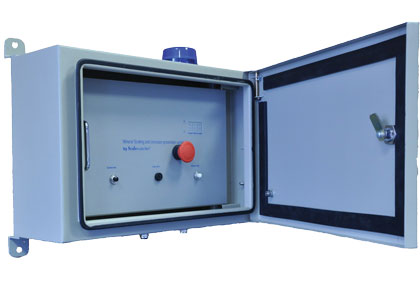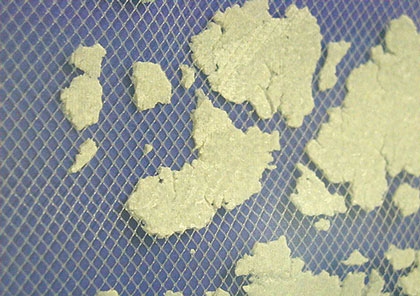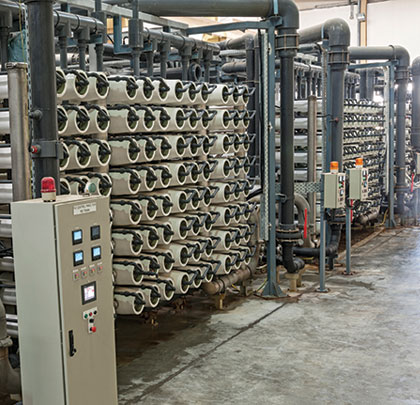Reverse osmosis (RO) is used in processes requiring high-quality, purified water, such in semi-conductor processing or biochemical applications and can be used to treat boiler feed water, industrial wastewater or process water. A water purification technique, it reduces the quantity of dissolved solids in solution. RO uses waterline pressure together with energy consuming pressurizing pumps that increase the required yield. It is essentially a molecular squeezing process that causes water molecules to separate from the contaminants. The separated water molecules then pass through to the inside of the membrane on to a holding reservoir. The contaminants are washed from the membrane and removed.
One of the major problems of RO systems is the fouling of membranes which can quickly become clogged by hard water scale resulting in less membrane space for the water to pass through, therefore leading to more pressure being required to reach the necessary yield. The consequences are higher energy use, an increase of the cleaning frequency and a shorter life span of the membranes. This will cause the membrane water treatment process to become much more expensive.
REVERSE OSMOSIS MEMBRANE
A reverse osmosis membrane must be freely permeable to water, highly impermeable to solutes, and able to withstand high operating pressures. Ideally, it should also be resistant to scaling and fouling by contaminants in the feed water. Water hardness, also known as limescale, is made up of calcium and magnesium carbonates and can be found in both city and well and spring water sources. Hard water (above 7 grains of hardness) will shorten the life of the RO’s membrane. Limescale fouling occurs when contaminants accumulate on the membrane surface effectively plugging the membrane. The results of limescale build-up are a higher pressure drop across the system. This translates into higher operating costs and eventually the need to clean or replace the RO membranes.
SCALING AND ELECTRONIC WATER TREATMENT
Scaling refers to the precipitation and deposition within the system and will to some extent take place eventually given the extremely fine pore size of an RO membrane no matter how effective the pre-treatment. However, by having proper pre-treatment in place, it is possible to minimize RO downtime and maintenance costs. It will maximize efficiency and membrane life by minimizing fouling, scaling and membrane degradation while optimizing product flow.
Electronic water treatment (EWT) is the ideal solution for preventing limescale build-up in RO membranes. A fit and forget technology it requires no plumbing, chemicals or salt. To explain the effect of electronic scale removal it is first important to understand the major factors that cause scale.

SUPER SATURATION
Aqueous solutions can become supersaturated, which means that they contain higher concentrations of dissolved solute than their equilibrium concentration. Such solutions are not stable and are easily triggered into dropping back to saturation level, forcing the dissolved compound to precipitate. Even when a bulk solution is less than fully saturated, scale formation can occur spontaneously due to localized super saturation, at a surface for example with a drop in calcium carbonate solubility, leading to the formation of mineral scale deposits.
In RO, the raw water and its components pass through the membrane filtering the pure water.
Therefore there is a steady process of supersaturation and precipitation of the water through the membrane. Within this environment electronic water conditions, such as Scalewatcher is the ideal solution for removing and preventing the membranes being clogged with scale. As electronic water treatment (EWT) changes the shape of the molecules from rough to smooth, they do not form a matted structure and are washed away thereby preventing the membranes from being clogged which in turn reduces maintenance shutdown and energy costs.
ELECTRONIC WATER CONDITIONING
EWT is a non-invasive system utilizing a solenoid coil or coils wrapped around the pipework to be treated. A continuously frequency changing signal generator, within a specified range, supplies current to the coils. The pulse shaped current creates an induced electric field, concentric around the axis inside the pipe. As a consequence to this arrangement, any charged particle or ion moving within the field experiences a so-called Lorentz force generated by the interaction between charged particles and magnetic and electric fields.
The treatment influences the initial nucleation, resulting in crystals that do not “stick” together. Untreated water builds up matted structures that continuously grow. This treatment creates idiomorphic, scattered crystals, which do not form matted structures. They have a rotundas shape, which means that they have a larger volume in relation to a smaller surface. This feature makes them sensitive to water currents and they are easily flushed out of the pipeline. As no new scale layers are formed, the sheer force of the water flow will gradually remove existing layers of scale. The ability to adjust power, frequency and coil configurations of products like the Scalewatcher on site enables performance to be optimized with no downtime and no pipe replacement.

CONCLUSION
Reverse osmosis technology is presently undergoing rapid growth in the area of municipal and industrial wastewater reuse. Control of membrane fouling due to scale and particles in wastewater is a major expense in the design and operation of these facilities. Installing a EWT system will save companies and organizations downtime and maintenance costs. ■
ABOUT THE AUTHOR
Jan de Baat Doelman is president of Scalewatcher North America Inc. The Scalewatcher is an environmentally friendly alternative to chemical and mechanical descaling. Launched in the 1980s it has successfully treated hard water problems for industrial manufacturers as well as water companies, oil producers, farmers, horticulturists, shipping companies, shopping centers, school, universities and government establishments. For more information, call 610.932.6888, email sales@scalewatcher.com, or visit www.scalewatcher.com.
MODERN PUMPING TODAY, July 2014
Did you enjoy this article?
Subscribe to the FREE Digital Edition of Modern Pumping Today Magazine!


